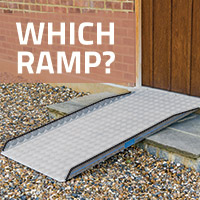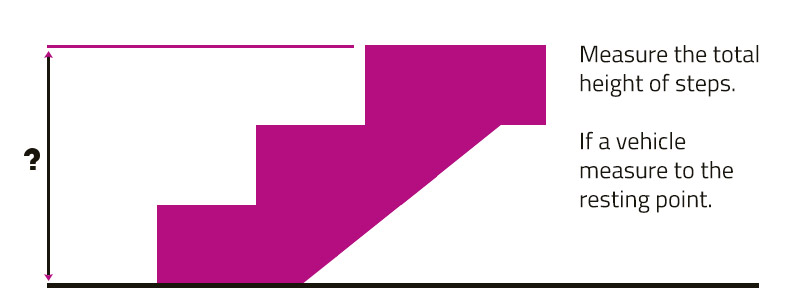
Are you struggling with steps or simply need to make access for goods or wheelchair users more friendly, yet baffled by the wide choice of ramps available? Then read on. Our helpful ramp specifier guide is designed to help you select the best access ramp for your requirements, taking into account the step height, and material coupled with space and portability and the needs of the user.
Step 1 - Which type of ramp?
The first step (sorry!) is to assess the use of the ramp and the step or threshold that you need it to cover.
> Door wedges create sleek slopes for internal thresholds.
> For steps and stairs, lightweight, high-rise ramps and those with hand rails are a good choice.
> On wooden door steps or thresholds with a flat access point, door wedges or aluminium ramps work well.
> PVC door thresholds require ultra-lightweight ramps to avoid damage to the PVC.
> For access to vehicles select a folding or telescopic ramp which can be stored in the vehicle when not in use.

Step 2 – How steep?
Measure the height of the tallest step, and consider these factors;
A ramp length 6 times the height of your tallest step will create a gradient of 1:6, or 10 degree angle.
This type of ramp is ok for using on short thresholds.
A ramp length 8 times the height of your tallest step will create a gradient of 1:8 or 8 degree angle.
If you are short of space this length of ramp can be suitable. It is also useful for portable ramps at events or where assistance is available.
A ramp length 12 times the height of you tallest step will create a gradient of 1:12 or 5 degree angle.
This is the most commonly required ramp by local authorities or social services. They are the minimum required specifications to comply with Building Regulations Document M for any installed ramp.
A ramp length 15 times the height of your tallest step will create a gradient of 1:15 or 4 degree angle.
The longest, and therefore easiest slope, sometimes required by local authorities or social services to create the most accessible entrance for independent access and most often used for permanently installed ramps designed for public access.
Step 3 - How long?
Taking into account the amount of space you have for your ramp, use this handy guide to help you decide which length of ramp best suits your requirements.
| Step height |
Length at 1:6 |
Length at 1:8 |
Length at 1:12 |
| 10cm (4ins) |
60cm (2ft) |
80cm (2ft 8ins) |
120cm (4ft) |
| 15cm (4ins) |
90cm (3ft) |
120cm (4ft) |
180cm (6ft) |
| 20cm (8ins) |
120cm (4ft) |
160cm (5ft 4ins) |
240cm (8ft) |
| 25cm (10ins) |
150cm (5ft) |
200cm (6ft 8ins) |
300cm (10ft) |
| 30cm (1ft) |
180cm (6ft) |
240cm (8ft) |
360cm (12ft) |
| 45cm (11ft 6ins) |
270cm (9ft) |
360cm (12ft) |
540cm (18ft) |
| 60cm (2ft) |
360cm (12ft) |
480cm (16ft) |
720cm (24ft) |
Take a look at our range of access ramps >
If you require further information or advice on selecting the correct ramp, give our technical team a call on 0808 278 3258 and they’ll be happy to help.